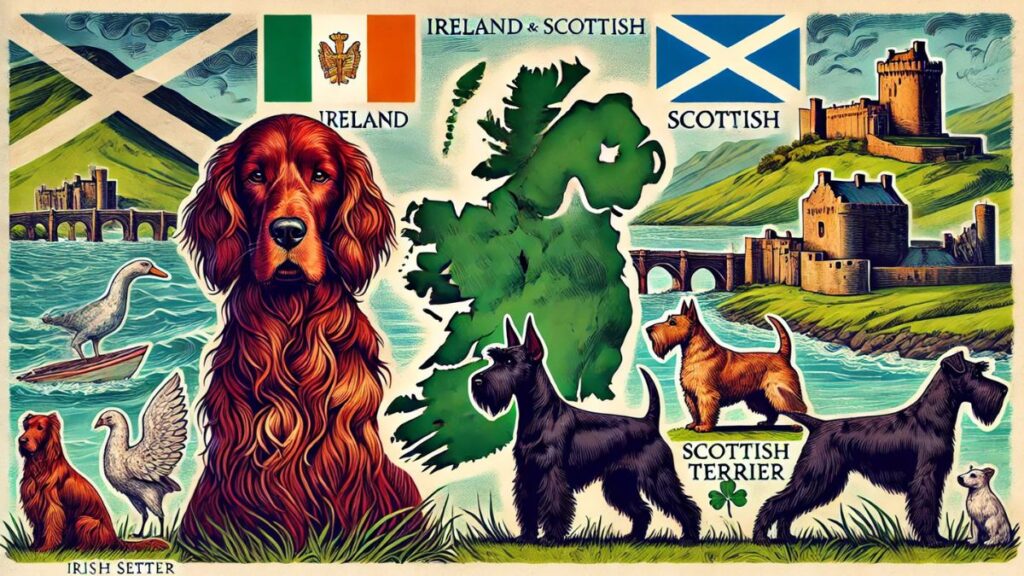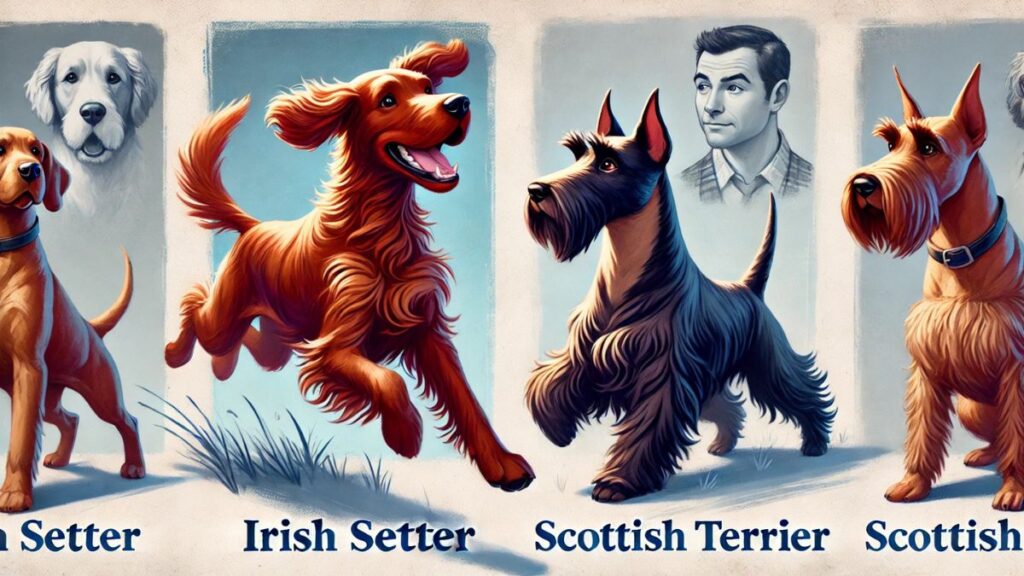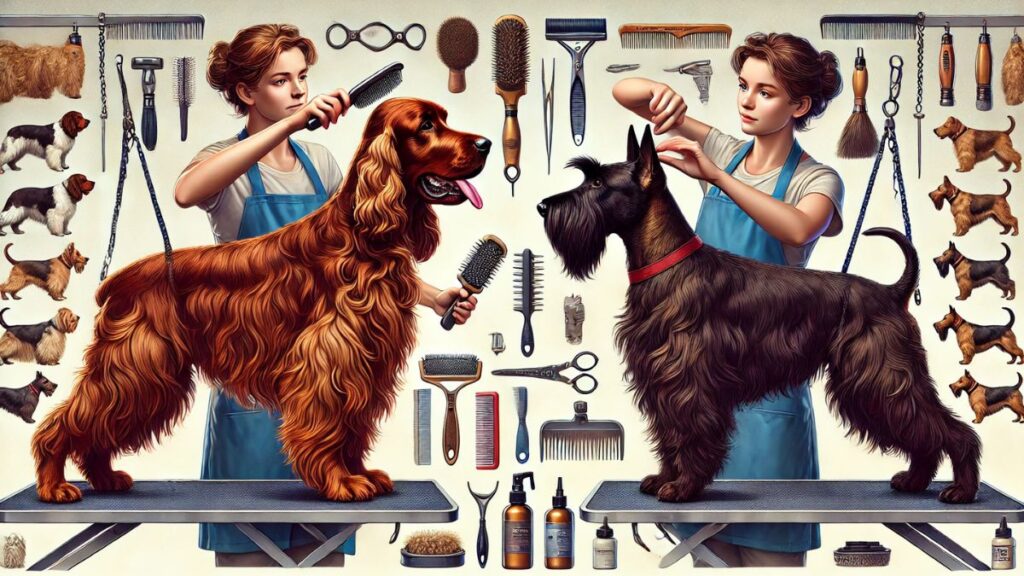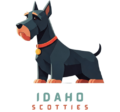Choosing a dog is like picking between a race car and a rugged off-road vehicle. One is built for speed and adventure, the other for determination and grit. The Irish Setter vs Scottish Terrier debate highlights this contrast perfectly.
The Irish Setter, with its flowing red coat and boundless energy, thrives on activity and companionship. The Scottish Terrier, small but fearless, is a loyal watchdog with an independent streak.
Dogs aren’t just pets—they’re lifelong companions. With over 65 million U.S. households owning a dog, it’s clear that picking the right breed matters. But not all dogs fit every lifestyle. Do you want a running partner or a steadfast guardian? A playful extrovert or a dignified protector?
In this guide, we’ll break down the history, temperament, exercise needs, and family compatibility of these two iconic breeds. By the end, you’ll know exactly which one is the perfect match for you.
Irish Setter vs Scottish Terrier
Trying to choose between an Irish Setter vs Scottish Terrier? One’s all about speed and adventure, while the other is fearless and independent. Let’s dive into what makes each breed unique and help you find the perfect match for your lifestyle!
Historical Background and Origins

Curious about where the Irish Setter vs Scottish Terrier came from? Let’s explore their fascinating history and origins, and discover how these two iconic breeds became the loyal companions we know today!
Irish Setter: A Fast and Friendly Hunter
The Irish Setter comes from Ireland, where it was bred to help hunters find birds. It was fast and smart, with a great sense of smell.
Over time, people started to love the Irish Setter as a friendly family pet. With its beautiful red coat and playful nature, it became popular in homes everywhere.
Scottish Terrier: A Small but Tough Hunter
The Scottish Terrier, or Scottie, comes from Scotland, where it was bred to hunt rats and other small animals. It is small but strong, with a bold and fearless personality.
Scotties are independent and determined. Over time, they also became loyal companions, loved for their brave and confident nature.
Physical Characteristics and Size

Curious about the physical characteristics and size of the Irish Setter vs Scottish Terrier? Let’s take a closer look at their builds, coats, and how their size and appearance make each breed unique!
Irish Setter
- Size: Tall and athletic
- Height: 25–27 inches
- Weight: 60–75 pounds
- Build: Lean, muscular body built for speed
- Coat:
- Long and silky
- Rich red or mahogany color
- Feathered fur on ears, chest, legs, and tail
- Appearance: Elegant and graceful with expressive eyes
Scottish Terrier
- Size: Small but sturdy
- Height: Around 10 inches
- Weight: 18–22 pounds
- Build: Compact and muscular
- Coat:
- Short, wiry, and weather-resistant
- Usually comes in black, brindle, or grey
- Appearance: Bold look with a distinctive beard and bushy eyebrows, exuding confidence and independence
Temperament and Personality
Wondering about the temperament and personality of the Irish Setter vs Scottish Terrier? Let’s dive into how each breed behaves, their unique traits, and which one might be the perfect fit for your lifestyle!

Irish Setter
- Personality: Friendly, playful, and full of energy
- Temperament: Outgoing, affectionate, and social
- Great for: Families with kids, active individuals, and outdoor lovers
- Behavior:
- Loves to run, play, and be part of family activities
- Enjoys being around people and other pets
- Needs plenty of exercise and mental stimulation
Scottish Terrier
- Personality: Confident, independent, and sometimes stubborn
- Temperament: Loyal and protective but reserved with strangers
- Great for: Singles, smaller households, and those looking for a loyal companion
- Behavior:
- Strong-willed and prefers to do things on its own terms
- Devoted to its family but may be wary of unfamiliar people
- Less energetic than the Irish Setter but still enjoys play and short walks
Lifestyle Match
- Irish Setter: Best for active families or individuals who have time for exercise and play.
- Scottish Terrier: Ideal for smaller households or singles who appreciate a loyal but independent pet.
Exercise and Energy Levels
Curious about the exercise and energy levels of the Irish Setter vs Scottish Terrier? Let’s break down how active each breed is, so you can choose the one that matches your activity level and lifestyle best!

Irish Setter
- Energy Level: Very high, always ready to run and play
- Exercise Needs: 1–2 hours per day
- Best Activities:
- Long runs or jogs
- Fetch and agility games
- Off-leash play in a safe, open space
- Interactive training to keep their mind engaged
Scottish Terrier
- Energy Level: Moderate, enjoys activity but not overly demanding
- Exercise Needs: 30–45 minutes per day
- Best Activities:
- Short walks or backyard play
- Interactive toys and puzzle games
- Tug-of-war or scent-based games
- Brief but engaging training sessions
Physical Activity Suggestions
- For Irish Setters: Keep them active with daily outdoor play, structured exercise, and activities that allow them to run. They thrive on movement and mental challenges.
- For Scottish Terriers: Keep exercise short but engaging, mixing walks, indoor play, and mental stimulation to match their independent nature.
Grooming and Maintenance
Thinking about grooming needs? Let’s explore the grooming and maintenance requirements of the Irish Setter vs Scottish Terrier, so you’ll know exactly what it takes to keep your dog looking and feeling their best!

Irish Setter
- Coat: Long, silky, and prone to tangles
- Brushing: Needs daily brushing to prevent knots
- Shedding: Sheds moderately all year, more during shedding seasons
- Bathing: Needs a bath every few weeks, especially after outdoor play
- Grooming Needs: May need professional grooming to keep its coat healthy
Scottish Terrier
- Coat: Short, wiry, and low-shedding
- Brushing: Needs weekly brushing to stay neat
- Shedding: Minimal shedding, good for those who prefer less fur around
- Bathing: Only needs a bath once in a while, as too much washing can dry out its coat
- Grooming Needs: Requires trimming or hand-stripping every few months
Simple Comparison
- Irish Setter: More brushing, more shedding, and more grooming effort.
- Scottish Terrier: Less shedding, but needs occasional trimming.
Health and Lifespan
Wondering about the health and lifespan of the Irish Setter vs Scottish Terrier? Let’s take a closer look at each breed’s common health issues and average lifespan, so you can make an informed decision for the long-term care of your new companion!
Irish Setter
- Common Health Issues:
- Hip dysplasia (joint problems)
- Bloat (a serious stomach condition)
- Eye conditions (like progressive retinal atrophy)
- Lifespan: 12–15 years with good care
- Health Tips:
- Regular exercise to maintain joint health
- Proper diet to prevent bloat
- Routine vet check-ups to catch issues early
Scottish Terrier
- Common Health Issues:
- Allergies (skin and food-related)
- Kidney problems
- Bladder cancer (more common in the breed)
- Lifespan: 11–14 years with proper care
- Health Tips:
- Regular vet visits for early detection
- Balanced diet to support kidney health
- Allergy management with proper grooming and diet
Overall Health Comparison
- Irish Setter: Needs careful monitoring for joint and digestive issues.
- Scottish Terrier: Prone to specific health conditions like bladder cancer but has fewer mobility concerns.
- Both Breeds: Benefit from routine vet check-ups, a proper diet, and early detection of health issues.
Training and Intelligence
Curious about how easy it is to train an Irish Setter vs Scottish Terrier? Let’s dive into their training needs and intelligence, so you can pick the breed that matches your patience and experience level!

Irish Setter
- Intelligence: Smart and eager to please but easily distracted
- Training Style:
- Positive reinforcement works best (treats, praise, play)
- Needs short, engaging sessions to stay focused
- Early training is important to manage excitement
- Challenge: Can be distracted by sights and smells, so patience is key
Scottish Terrier
- Intelligence: Smart but strong-willed and independent
- Training Style:
- Needs firm, consistent commands
- Short, reward-based sessions work best
- May ignore commands if bored or uninterested
- Challenge: Can be stubborn and prefers to do things its own way
First-Time Owner Considerations
- Irish Setter: Easier for first-time owners if they’re patient and consistent. Loves learning but needs mental stimulation.
- Scottish Terrier: Better for experienced owners who can handle an independent dog. Requires clear leadership and consistency.
Family Compatibility and Lifestyle Considerations
Not sure which breed fits your family? Let’s explore the family compatibility and lifestyle considerations of the Irish Setter vs Scottish Terrier, helping you choose the dog that will seamlessly blend into your home and daily routine!

Irish Setter
- Best For: Active families with kids and other pets
- Living Space: Needs a home with a yard to run and play
- Social Behavior:
- Friendly and loves being around people
- Gets along well with other pets
- Key Considerations:
- Needs lots of exercise and attention
- May not do well in small apartments without enough activity
Scottish Terrier
- Best For: Quieter households or singles
- Living Space: Can adapt to apartment living if exercised regularly
- Social Behavior:
- Loyal but can be territorial if not socialized early
- More reserved around strangers
- Key Considerations:
- Prefers a structured routine
- Needs training to prevent overprotective behavior
Overall Lifestyle Factors
- Irish Setter: Ideal for active families with space and time for play.
- Scottish Terrier: Better for smaller households or city life with daily walks.
- Both Breeds: Need consistent exercise and attention, but in different ways.
Cost and Availability
Wondering about the cost and availability of the Irish Setter vs Scottish Terrier? Let’s break down what you can expect to pay for each breed and how easy it is to find your perfect companion, so you can plan ahead!
Initial Costs (Purchase or Adoption)
- Irish Setter: Usually $800–$2,500 from a breeder
- Scottish Terrier: Typically $1,000–$3,000 from a breeder
- Adoption fees for both breeds range from $100–$500
Ongoing Expenses
Food:
- Irish Setters eat more due to their size (higher monthly cost)
- Scottish Terriers eat less, making food costs lower
Grooming:
- Irish Setters need daily brushing and occasional professional grooming
- Scottish Terriers require specialized trimming or hand-stripping every few months
Healthcare:
- Regular vet check-ups, vaccinations, and potential breed-specific health concerns
- Irish Setters may have higher medical costs due to size-related issues like hip dysplasia
- Scottish Terriers may need specific health screenings for genetic conditions
Availability
- Where to Find Them:
- Reputable Breeders: Look for breeders who follow ethical breeding practices and provide health clearances
- Rescue Organizations & Shelters: Some Irish Setters and Scottish Terriers can be found in breed-specific rescues or general adoption centers
- Online Pet Adoption Platforms: Websites like Petfinder or AKC Rescue Network can help locate available dogs
Overall Cost and Availability Factors
- Irish Setter: Higher food costs, moderate grooming needs, and may be harder to find in rescues.
- Scottish Terrier: Lower food costs, but grooming expenses can add up. More common in rescues than Irish Setters.
Special Considerations
Considering an Irish Setter vs Scottish Terrier? Let’s take a look at some special considerations, from grooming needs to temperament quirks, so you can choose the breed that truly fits your lifestyle and home environment!
Hunting vs. Companion Roles
- Irish Setters: Originally bred for hunting, they are now loving family companions.
- Scottish Terriers: Bred to hunt small animals, they still show strong hunting instincts.
Hypoallergenic Traits
- Scottish Terriers are low-shedding and may be a better choice for people with allergies.
Managing Terrier Stubbornness
- Scottish Terriers can be stubborn. They need patient, consistent training using clear commands and rewards.
Barking Control
- Irish Setters: May bark when excited but are not overly noisy.
- Scottish Terriers: Might bark more, especially if guarding their space, so early training can help manage this behavior.
Conclusion and Next Steps
Still unsure whether the Irish Setter vs Scottish Terrier is the right choice for you? Let’s wrap up with a quick summary and the next steps to help you make an informed decision and find the perfect dog for your home and lifestyle!
Summary of Key Differences
History & Purpose
- Irish Setter: Originally bred for hunting, known for speed and grace.
- Scottish Terrier: Bred as a vermin hunter, known for independence and loyalty.
Physical Traits
- Irish Setter: Large, lean, with a long, silky red coat.
- Scottish Terrier: Compact, sturdy, with a short, wiry coat.
Temperament & Training
- Irish Setter: Friendly, playful, and eager to please, but easily distracted.
- Scottish Terrier: Loyal but stubborn, requiring firm and consistent training.
Exercise & Grooming
- Irish Setter: Needs 1–2 hours of daily exercise and frequent grooming.
- Scottish Terrier: Needs 30–45 minutes of exercise and regular coat maintenance.
Health & Cost
- Irish Setter: Higher food and medical costs due to size. Prone to hip dysplasia and bloat.
- Scottish Terrier: Lower food costs, but may have higher grooming expenses. Prone to allergies and bladder cancer.
Final Recommendations
- Best for Active Families with Space: Irish Setter
- Best for Smaller Homes or Apartment Living: Scottish Terrier
- Easier to Train for First-Time Owners: Irish Setter (if patient)
- Better for Experienced Owners Who Prefer an Independent Dog: Scottish Terrier
Next Steps
✔ Visit breeders, rescues, or shelters to meet both breeds in person.
✔ Talk to current owners to understand real-life experiences.
✔ Consider lifestyle needs before making a final decision.
No matter which breed you choose, both can make wonderful companions with the right care and commitment!
FAQs
Can Irish Setters adapt to cold climates?
Yes, they can, but they have a thinner coat and might need a warm jacket in very cold weather.
Do Scottish Terriers shed?
They shed very little. Their wiry coat produces minimal fur, though it does need regular grooming.
How do they interact with other pets?
Irish Setters: Generally friendly and social with other dogs and cats.
Scottish Terriers: Can be territorial; early socialization helps them get along better.
Pet trainer with a passion for helping animals and owners build strong, loving bonds through positive reinforcement and expert care.



